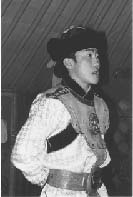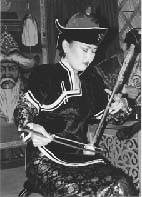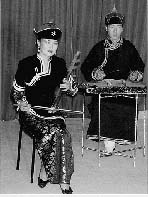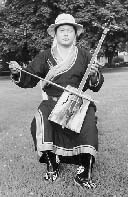|
- Catalog (in stock)
- Back-Catalog
- Mail Order
- Online Order
- Sounds
- Instruments
- Projects
- History Face
- ten years 87-97
- Review Face
- our friends
- Albis Face
- Albis - Photos
- Albis Work
- Links
- Home
- Contact
- Profil YouTube
- Overton Network
P & C December 1998
- Face Music / Albi
- last update 03-2016
|
1. Ujakhan zambuutiviin naran - 3:35
2. Junden Göögöö - 2:09
3. Melkhii - 2:09
4. Sünjidmaa - 2:38
5. Khökh torgon dääl - 2:13
6. Erüü tsagaan bolshmor - 2:15
7. Siilen Böör - 1:51
8. Bujant gol - Khonin joroo mori - 1:42
9. Üzäsgälän goo - Um zandan shirää - 3:23
10. Sudgiin nogoo - 2:28
11. Gandan Uuliin tsetseg - 3:55
12. Ider tshintshin - 2:36
13. Sender okhin - 2:55
14. Tshaakhan sharga - 3:41
15. Hulsan tashuur - 3:00
16. Mandakh nar - Shiiden khuar - 3:05
17. Gandii mod - 2:45
18. Tsombon tuuraitai khüren - 2:18
19. Khojor Setgel - 1:36
20. Algirmaa - 2:10
21. Hel khuur - 3.02
22. Ülemtshiin tshanar - 2:42
23. Düüriimaa - 2:28
24. Höömiin törluud - 4:15
25. Dörvön nastai khaliun - Goodj Nanaa - 1:55
26. Tsenkherlen kharagdakh Uuls - 3:39
27. Jantshuur tamkhi - Dörvön Uul - 1:57

Ensemble Ardiin Ayalguu, Mongolia
Songs
1. Ujakhan zambuutiviin naran
- Batsaikhan: morin khuur - solo - long song (urtiin duu)
|
This is a philosophic song about life and wisdom. It is said that the sun (nar) and the world (zambuutiviin) are eternal. Therefore, one should not compare them with the short human life.
|
2. Junden Göögöö
- Batsaikhan: morin khuur, Solongo: khuuchir, Barkhuu: yoochin, Enkhjargal: limbe - short song (bogino duu)
|
This is the legend of a young and handsome man of the name of Junden Göögöö. He was living in the middle of the 19th century in the region of the river Khalkh (Dornod-Aimak). He was a dexterous wrestler and archer as well as a good singer. He wore his hair long like a woman and he had a dark skin. Up to date, whenever Mongolian girls talk about a young handsome man, they call him Junden Göögöö.
|
3. Melkhii
- Batsaikhan: morin khuur, Solongo: khuuchir, Barkhuu: yoochin, Enkhjargal: limbe - short song (bogino duu)
|
Two men are sitting outside in the steppe drinking milk brandy (mongol arkhi). A green frog (melkhii) hops towards them and jumps right into the brandy jug. Drunkenly it struggles out of the jug and steals away. But the two men notice this and make fun of its drunkenness.
|
4. Sünjidmaa
- Batsaikhan: morin khuur - solo - short song (bogino duu)
|
This song tells the story of the sincere and true love of a Mongolian man for the Mongolian woman called Sünjidmaa.
|
5. Khökh torgon dääl
- Batsaikhan: morin khuur, Solongo: khuuchir, Enkhjargal: limbe - short song (bogino duu)
|
The blue silken coat (khökh torgon dääl). This is the story of the fate of the prince's wife Badam, who had lived during the years of the revolution (1920-1930) and had been forcedly wedded to the old prince by her parents.
|
While embroidering the blue silken coat, Badam is dreaming of a young man. To appease her husband she sings songs in which she expresses her wishes and her love, hoping to be heard and wishing that someone would elope with her and liberate her from this predicament.
|
6. Erüü tsagaan bolshmor
Batsaikhan: morin khuur, Solongo: khuuchir, Barkhuu: yoochin, Enkhjargal: limbe - short song (bogino duu)
|
The little bird (bolshmor - lark) with the white collar (tsagaan erüü). Like this little bird, the woman is "chirping" all day long, thus getting on her husband's nerves. He gets very angry and begins to be abusive. Now she feels offended, but this doesn't last for long and the two get again along well together. This song describes the ups and downs that occur in a marriage.
|
7. Siilen Böör
- Solongo: khuuchir - solo - short song (bogino duu)
|
A Mongol has shot dead his fiancée's father by mistake, whereas he had only intended to scare him with a shot from his rifle.
|
8. Bujant gol - Khonin joroo mori
- Batsaikhan: morin khuur, Barkhuu: yoochin, Enkhjargal: höömij - two short songs (bogino duu)
|
- Bujant gol. This is a song about the river Bujant.
|
- The leisurely tripping horse (khonin joroo mori). The Mongols love horses with such a character and they always hope that their life partner will have just such a character.
|
9. Üzäsgälän goo - Um zandan shirää
Batsaikhan: morin khuur, Solongo: khuuchir, Barkhuu: yoochin, Enkhjargal: limbe - two short songs (bogino duu)
|
- Beautiful women (üzäsgälän goo). It is a common trait to men to dream often and with pleasure of beautiful and pretty women as it is described in this song.
|
- The precious wooden table (zandan schirää). A young Mongolian woman polishes the precious wooden table and lays it for the arriving guests. She hopes that among them will also be a young man she could like and fancy to be given to in marriage by her parents.
|
10. Sudgiin nogoo
- Batsaikhan: morin khuur, Solongo: khuuchir, Barkhuu: yoochin, Enkhjargal: limbe - short song (bogino duu)
|
In the gorge (sudgiin), where the grass (nogoo) is growing well and splendidly a Mongolian woman is waiting impatiently for her lover to return. The seasons change. She often tries not to think of him, but several years pass until her beloved one finally returns.
|
11. Gandan Uuliin tsetseg
- Batsaikhan: morin khuur, Enkhjargal: limbe - short song (bogino duu) |
Flowers (tsetseg) on Gandan Mountain (uul). There is an elderly man, who loves the flowers growing high up on this mountain. Every year he rejoices when they grow and flourish once more. But sadly he observes how they wither and die in autumn. Therefore he wants to be mindful and take care of his heart, so it won't wither like these flowers.
|
12. Ider tshintshin
- Enkhjargal: limbe - solo - long song (urtiin duu)
|
This is a song about a young (ider) cameleer (tshintshin - also: nomad), who travels through the desert with his caravan. He sings about his love for the camels, his work and his homeland.
|
13. Sender okhin
- Batsaikhan: morin khuur, Solongo: khuuchir, Barkhuu: yoochin, Enkhjargal: limbe - short song (bogino duu)
|
This song is about a girl (okhin) called Sender. She is very clever and beautiful and has an incredible will power.
|
14. Tshaakhan sharga
- Batsaikhan: morin khuur - solo - long song (urtiin duu)
|
A Mongol is riding on his yellow-brown small horse (tshaakhan scharga) across the steppe and sings about the ups and downs he had experienced in matters of love and in his everyday life.
|
15. Hulsan tashuur
- Batsaikhan: morin khuur, Solongo: khuuchir, Barkhuu: yoochin, Enkhjargal: limbe - short song (bogino duu)
|
The whip made of bamboo (hulsan tashuur). This is a song about the 220 years of slavery under the Mansha with their hard laws. The young Mongols were summoned for active military duty and were drilled hard. They sing about the beauty of their homeland Mongolia and their love for her, and their hope to get their freedom back again soon.
|
16. Mandakh nar - Shiiden khuar
- Solongo: khuuchir - solo - two short songs (bogino duu)
|
- The rising sun (mandakh nar). The song speaks of the happiness and love of newly married women and how they are dreaming of their husbands, who had just entered military service.
|
- Shiiden khuar: traditional melody.
|
17. Gandii mod
- Batsaikhan: morin khuur, Solongo: khuuchir, Barkhuu: yoochin, Enkhjargal: limbe - short song (bogino duu)
|
This song describes how a started up flock of birds returns and alights on a tree (mod). A young woman is watching the birds and hopes that her lover will return, too. She is thinking of their love and happiness.
|
18. Tsombon tuuraitai khüren
- Batsaikhan: morin khuur, Enkhjargal: limbe - long song (urtiin duu)
|
The hoofs (tuuraitai) of the brown one (khüren) are good (tsombon – meaning strong, powerful hoofs). This song speaks about the Mongolian woman Engiimaa's love and how she is missing her husband after their separation. Her good character and her excellent manners and good (tsombon) nature are praised, too.
|
19. Khojor Setgel
- Solongo: khuuchir - solo - short song (bogino duu)
|
Mongols, who have fallen in love sing about it, about the two souls and the two hearts and how they find each other and become one.
|
20. Algirmaa
- Batsaikhan: morin khuur, Solongo: khuuchir, Barkhuu: yoochin, Enkhjargal: limbe - short song (bogino duu)
|
After Algirmaa's husband had been called up for military service, his parents chased her from their house. Now she is waiting patiently for her husband's return. Finally he comes back and takes his wife home again.
|
21. Hel khuur
- Enkhjargal: tömör hel khuur (jew's harp made of brass) - solo
|
22. Ülemtshiin tshanar
- Batsaikhan: morin khuur - solo - short song (bogino duu)
|
This song describes the beauty of women, their feelings and their senses, such as that of smelling, of touch, of hearing, of sight and of feeling. Women have different characters and qualities.
|
23. Düüriimaa
- Batsaikhan: morin khuur, Solongo; khuuchir, Enkhjargal: limbe - love song - short song (bogino duu)
|
This song speaks of a Mongol's love for his fiancée called Düüriimaa and how he is missing her and singing of her.
|
24. Höömiin törluud
- Enkhjargal: höömij - (törluud - various forms of overtone singing)
|
25. Dörvön nastai khaliun - Goodj Nanaa
- Batsaikhan: morin khuur, Enkhjargal: höömij - long song (urtiin duu) and short song (bogino duu)
|
- The four-year-old (dörvön nastai) brown one (khaliun). This is a song about the combats of the princes and their oppression. The singer tells that he survived his beloved brown one and is missing him now.
|
– The famous singer Goodj Nanaa once sang this song. It speaks of the Mongols' characteristics in love matters, of the beauty of their homeland and of the hard daily life.
|
26. Tsenkherlen kharagdakh Uuls
- Batsaikhan: morin khuur, Solongo: khuuchir - short song (bogino duu)
|
The silvery blue mountains on the horizon. It is sung of their radiation and their beauty.
|
27. Jantshuur tamkhi - Dörvön Uul
- Batsaikhan: morin khuur, Solongo: khuuchir, Barkhuu: yoochin, Enkhjargal: limbe - two short songs (bogino duu)
|
- Cigarettes (jantshuur tamkhi). A woman, who had drunk much and had led an extravagant and swell life, is reflecting on her past and now she recognises what she had really been doing.
|
– A song for the four mountains around Ulaan Baatar. The song originates in the time when the name of the capital was still Örgöö.
|
Instruments
The nomad shepherds in Mongolia, like other nomads from central Asia, use to play string- and wind instruments.
Percussion instruments though, were only used in connection with Shamanism and Buddhism, the origins of which are to be found in the Tibetan Lamaism, as well as with the "Tsam Dance", which was performed in Mongolia for the first time in the 8th century.
|
- Hel khuur (Jew's harp)
|
|
Nowadays, a Jew's harp is made of brass or steel, but in earlier days it was made of wood or bamboo. A spring, acting as a vibrator, is fitted into a horseshoe-shaped metal holder and is called 'tongue'. The player places the long part of the instrument close to his mouth, touching it with his front teeth and manipulating the tongue with his right hand. The pitch can be varied by changing the shape of the mouth cavity, which at the same time acts as a resonance chamber.
|
|
- Tsuur (wind instrument)
|
|
The tsuur is a traditional Mongolian wind instrument (flute) made of "uliangar" wood (bur chervil - umbellifer). Melody and sound resemble the sound of the waterfall of the River Jeven. The "aman tsuur" made by the Altai-Uriankhai tribes are the most popular ones and produce the best sound.
|
|
- Limbe (wind instrument)
|
|
The instrument is frequently used in accompaniment, occasionally also as a solo instrument. In former times it was made of bamboo or wood, nowadays mostly of plastic, particularly those imported from China. These flutes (transverse flutes) are closely bound up with the nomads of Central Asia.
|
|
The length of this instrument is approx. 64 cm, with nine holes, whereof one is the blowhole and two others are reserved for the tuning. It is often played with circular breathing*. The sound reflects what is heard in the nature or the sounds of the natural and social environment.
|
|
- *Circular breathing: one note is blown, while the musician inhales through his nose. The air is collected inside the cheeks and exhaled by the pressure of the cheeks' muscles (same principle as for the bagpipe). The base of the tongue is used as a valve.
|
|
- Khun tovshuur - Tovshuur (string instrument)
|
|
The khun tovshuur is a two-stringed instrument similar to the lutes of Tuva, Altai or Kazakhstan. The body and the neck are carved from cedar wood and the body is often coated with the leather of wild animals, camels or goats. The strings are plaited with the horsetail hair and tuned in the interval of a fourth.
|
|
The West Mongols use this lute to accompany the "tuuli" (heroic-epic myths) and "magtaal" (praise songs).
|
|
- Khuuchir (string instrument)
|
|
The nomads (called "the savages") formerly mainly used the snake skin violin or horsetail violin. The Chinese call it "the Mongol instrument" or "Huk'in". It is tuned in the interval of a fifth and is small or middle sized.
|
|
The khuuchir has a small, cylindrical, square or cup-like resonator made of bamboo, wood or copper, covered with a snake skin and open at the bottom. The neck is inserted in the body of the instrument. It usually has four silk strings, of which the first and the third are accorded in unison, whereas the second and fourth are tuned in the upper fifth. The bow is coated with horsetail hair and inseparably interlaced with the string-pairs; in Chinese this is called "sihu", that is "four", also meaning, "having four ears". The smaller instruments have only two strings and are called "erh'hu", that is "two" in Chinese.
|
|
- Morin khuur (string instrument - horse-head-violin)
|
|
The morin khuur is a typical Mongolian two-stringed instrument. The body and the neck are carved from wood. The end of the neck has the form of a horse-head and the sound is similar to that of a violin or a cello. The strings are made of tried deer or mountain sheep sinews. It is played with a bow made of willow, stringed with horsetail hair and coated with larch or cedar wood resin.
|
|
This instrument is used to play polyphonic melodies, because with one stroke of the bow the melody and drone-strings can be played at the same time. The morin khuur is the most widespread instrument in Mongolia, and is played during celebrations, rituals and many other occasions, as well as an accompaniment for dances or songs. Even the sound and noises of a horse herd are imitated on the morin khuur.
|
|
People say that it is connected with a handsome man. It is also played when a ewe doesn't want to suckle her lamb.
There is a legend about the origin of this instrument. A Mongol missed his dead horse so much that he used its head, its bones and its hair to build an instrument on which he started to play the familiar noises of his beloved horse.
|
|
- Yoochin (string instrument)
|
|
Box zither - dulcimer with 13 double-wire strings. The strings are struck with two wooden sticks, so-called little wooden hammers (comparable with the santur of the Persians). It has a black wooden soundboard richly decorated with ornaments.
The instrument was only familiar to townspeople and first of all only they played it. |
 
Enkhjargal, höömij - Solongo, khuuchir
Vocal music
|
- Urtyin duu - long song, |
|
melismatic and richly ornamented, with a slow tempo, long melodic lines, wide intervals and no fixed rhythm.
|
|
It is sung in verses, without a regular refrain and with a full voice in the highest register. The melody has a coat which covers over three octaves. This requires a strict observance of the breathing rules. The breathing is actually free, but the singer has to keep to the strict rules of performance, making only the abolutely necessary breathing breaks without interrupting the melodic ornaments. The richer the voice is and the longer the singer can hold it, the more internsive is the attention paid by the auditors and the more his performance is appreciated.
|
|
People usually practise these long songs while being alone in the open steppe and riding along slowly. The repertory is an expression of the liberty and the vastness of the Mongolian steppe and is used to accompany the rites of the seasonal cycles and the ceremonies of everyday life. Long songs are an integral part of the celebrations held in the round tents and they must be sung after the strict rules of performance. |
|
There are three categories of long songs: |
|
- The shortened ones have short verses, refrains and melodic courses full of leaps and bounds. |
|
- The extended ones with uninterrupted flowing melodies, richly ornamented, containing long passages in falsetto. |
|
- The usual ones are shorter, less ornamented and without falsetto.
|
|
- Bogino duu - short song |
|
strophic, syllabic, rhythmically tied, sung without ornaments.
|
|
Short songs are never used at celebrations, since they are spontaneously improvised and rather satirical. They are often lyrical tales about love, about the everyday life and about animals, especially horses.
|
|
- Tuuli - heroic-epic myths
|
|
Mongolian epics report about fierce fights between the good and evil powers in a highly qualified literary poetry.
The recital of epics was always bound to rituals and it was believed to have magical power. The recitation should have a favourable influence on natural spirits as well as the power to expulse evil spirits. Generally, the epics were sung inside the round felt tents of the shepherds, during the period of their search for the winter quarters, before the hunt or a battle, and against infertility or disease.
|
|
- Magtaal - praising songs
|
|
Magtaal are sung in honour of the gods of Lamaism and the nature spirits, heralds or particular animals. Epic texts also contain praise songs for the mountains, the rivers and nature in general. This is an ancient tradition still practised up to date by the tribes in the region of Mongol-Altai in Western Mongolia.
|
|
- Khöömij - overtone singing
|
|
The performance of overtone singing takes usually place during social events such as eating or drinking parties. |
|
The Mongols call their overtone singing höömij (= throat, pharynx). The singer creates a constant pitched fundamental considered as a drone, and at the same time modulates the selected overtones to create a formantic melody from harmonics. |
|
Several techniques are known, depending on the vocal source and the place of resonance: kharkhiraa = lung, khamriin = nose, tövönkhiin = throat and bagalzuuriin = pharynx. Overtone singers form and vary sound and timbre with their mouth, teeth, tongue, throat, nose and lips. They always form two distinct tones simultaneously sustaining the fundamental pitch. |
|
Overtone singing can also be heard from Turkic-speaking tribes in disparate parts of central Asia. The Bashkir musicians from the Ural Mountains call their style of overtone singing uzlyau; the Khakass call it khai, the Altai call it koomoi and the Tuvinians khoomei. |
|
Up to date, overtone singing is a common feature of Siberian peoples as well as the Kazakhs and Mongolian tribes. Overtone or throat singing is a special technique in which a single vocalist produces two distinct tones simultaneously. One tone is a low, sustained fundamental pitch (a kind of drone) and the second is a series of flutelike harmonics, which resonate high above this drone. Who masters this singing technique may even make the overtone sound louder then the fundamental pitch, so the drone is not audible anymore. A different technique often used by overtone singers combines a normal glottal pitch with the low frequency, pulse-like vibration known as vocal fry. The Turkic tribes in the Altai use to sing their texts in such a low vocal fry register of about 25-20 Hz). |
 
- Solongo, khuuchir - Barkuu, yoochin -- Batsaikhan, morin khuur -
|
